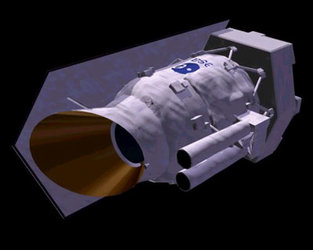9 April
1998: On 9 April 1998, scientists announced that ESA's Infrared Space Observatory (ISO) spacecraft had discovered a very steamy cloud in interstellar space.
A team of US astronomers discovered a large concentration of water vapour in a cloud of interstellar gas close to the Orion Nebula, using ISO, which was operated with the participation of NASA. ISO found water vapour in many places, from the outer planets to distant galaxies, but the concentration reported in 1998 was twenty times larger than that measured previously in other interstellar gas clouds.
The water vapour is in the Orion Molecular Cloud, a giant interstellar mass composed primarily of hydrogen molecules. The observations were carried out in October 1997 with the Long Wavelength Spectrometer, devised by a British-led team as one of four instruments on board ISO.
Looking at long infrared wavelengths, the astronomers saw the characteristic signature of emission by water vapour. "The interstellar gas cloud that we observed is being pummelled by shock waves that compress and heat the gas," says Martin Harwit of Cornell University, an ISO mission scientist.
"These shock waves are the result of the violent early stages of starbirth, in which a young star spews out gas that slams into its surroundings at high speed. The heated water vapour that we observed is the result of that collision."
The concentration of water vapour measured by the US team was roughly one part in 2000 by volume, far larger than any measured previously in interstellar space.

1959: On 9 April 1959, NASA announced the selection of its first astronauts for Project Mercury, an effort to learn if humans could survive in space.
NASA required astronaut candidates to be male, not older than 40 years of age, not more than 5 foot 11 inches (1.8 m) in height and in excellent physical condition. They were required to be a graduate of test pilot school and be a qualified jet pilot in possession of at least 1500 hours of flight experience. Astronaut candidates were also required to possess a bachelor's degree or the equivalent in experience. 110 people applied and, by careful screening, this number was reduced to seven.
The 'Mercury Seven' were Scott Carpenter, Gordon Cooper Jr., John Glenn Jr., Virgil 'Gus' Grissom, Walter M. Schirra Jr., Alan B. Shepard Jr., and Donald K. 'Deke' Slayton.
At a press conference in Washington, DC, on 9 April 1959, NASA introduced the Mercury Seven to the public. The press and public soon adopted them as heroes, embodying the new spirit of space exploration. Each one (except Slayton, who was grounded because of a previously undiscovered heart condition, but later flew as a crewmember of the Apollo Soyuz Test Project) successfully flew in Project Mercury. During the five-year life of the project, six manned flights and eight automated flights were completed, proving that human spaceflight was possible. These missions paved the way for the US Gemini and Apollo programmes.















 Germany
Germany
 Austria
Austria
 Belgium
Belgium
 Denmark
Denmark
 Spain
Spain
 Estonia
Estonia
 Finland
Finland
 France
France
 Greece
Greece
 Hungary
Hungary
 Ireland
Ireland
 Italy
Italy
 Luxembourg
Luxembourg
 Norway
Norway
 The Netherlands
The Netherlands
 Poland
Poland
 Portugal
Portugal
 Czechia
Czechia
 Romania
Romania
 United Kingdom
United Kingdom
 Slovenia
Slovenia
 Sweden
Sweden
 Switzerland
Switzerland

































